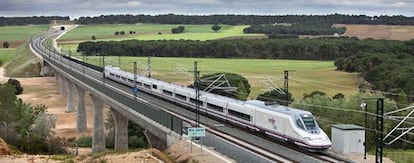Not one AVE high-speed rail line is turning a profit, says new study
Multi-billion investments made by past and current governments off track, report concludes


A new study presented on Thursday on the multi-billion euro investments made on Spain’s AVE high-speed rail system concludes that the costs are “neither beneficial to businesses nor society,” and do not compensate passenger savings in airline tickets or time spent on the road.
The Foundation for the Studies of Applied Economics (Fedea), which conducted an analysis of major AVE routes, said that the current demand for train services wasn’t enough to recover the investments made by past and current Spanish governments.
Spain has few passengers for the high number of AVE rail lines
Spain has few passengers for the high number of AVE rail lines, Fedea researchers Ofelia Betancor and Gerard Llobe said.
The network covers 2,515 kilometers and an additional 1,200 kilometers are currently under construction. Only China has more rail lines.
In comparative terms, there are 54 kilometers of track for every one million residents. In France that ratio drops to 31 kilometers per one million.
However, the number of travelers in Spain who use the high-speed rail service is much lower than in other countries. Researchers determined that there were 11,800 passengers for every kilometer compared with the 158,121 passengers per kilometer in Japan and 61,400 in France.
Fedea estimates that Spanish governments – including the current one – have spent more than €40 billion in constructing the rail system, with another €12 billion going to related work projects.
In the middle of an election year, the Public Works Ministry has announced that it will lay down an additional 1,200 kilometers of track that will connect eight provincial capitals.
Fedea blames governments for not making public cost analyses each time they decide build a new high-speed connection, and bemoaned “the high price Spanish society will have to assume as a result of such investment decisions.”
Spanish governments decided to make such huge investments for “political gain”
The only manner for the government to recover its losses is through a considerable increase of passengers, which doesn’t seem likely in the near future, researchers said.
The Public Works Ministry has projected a two-fold increase in rail passengers in the next five years. In the last year, there has been a 16-percent upturn with 29.7 million people reportedly using the AVE.
The study looked at traffic on AVE’s four major rail lines: Madrid-Barcelona, Madrid-Andalusia, Madrid-Levante and Madrid-North. Together, they carry 70 percent of all high-speed rail passengers.
As for the reasons why Spanish governments decided to make such huge investments, Fedea lists “political gain” with the justification of “providing jobs” and “developing a national industry” as factors.
“Our conclusions put in question the lack of fundamental economic reasons to make such investments in high-speed rail for Spain,” the researchers said.
Tu suscripción se está usando en otro dispositivo
¿Quieres añadir otro usuario a tu suscripción?
Si continúas leyendo en este dispositivo, no se podrá leer en el otro.
FlechaTu suscripción se está usando en otro dispositivo y solo puedes acceder a EL PAÍS desde un dispositivo a la vez.
Si quieres compartir tu cuenta, cambia tu suscripción a la modalidad Premium, así podrás añadir otro usuario. Cada uno accederá con su propia cuenta de email, lo que os permitirá personalizar vuestra experiencia en EL PAÍS.
¿Tienes una suscripción de empresa? Accede aquí para contratar más cuentas.
En el caso de no saber quién está usando tu cuenta, te recomendamos cambiar tu contraseña aquí.
Si decides continuar compartiendo tu cuenta, este mensaje se mostrará en tu dispositivo y en el de la otra persona que está usando tu cuenta de forma indefinida, afectando a tu experiencia de lectura. Puedes consultar aquí los términos y condiciones de la suscripción digital.
Últimas noticias
The complicated life of Francesca Albanese: A rising figure in Italy but barred from every bank by Trump’s sanctions
How Japan is trying to avert ‘digital defeat’
Half of Scotland is in the hands of 420 property owners
Reinhard Genzel, Nobel laureate in physics: ‘One-minute videos will never give you the truth’
Most viewed
- Pablo Escobar’s hippos: A serious environmental problem, 40 years on
- Why we lost the habit of sleeping in two segments and how that changed our sense of time
- Charles Dubouloz, mountaineering star, retires at 36 with a farewell tour inspired by Walter Bonatti
- Reinhard Genzel, Nobel laureate in physics: ‘One-minute videos will never give you the truth’
- The Florida Keys tourist paradise is besieged by immigration agents: ‘We’ve never seen anything like this’








































